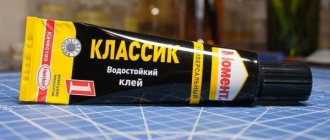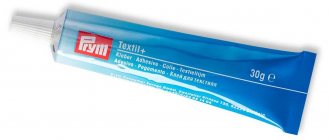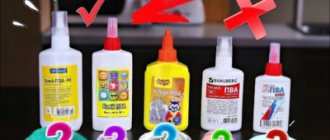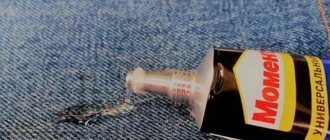The use of quick-drying adhesives is popular due to their ease of use and high-quality gluing of the necessary parts. Moment glue is often chosen for home repairs of various items, but during work you may encounter a situation where drops of the solution fall on surfaces that should not have been lubricated with it. Then you need to know how to wash super glue from your hands or other surfaces so as not to leave a trace and not spoil the surface. Possible ways to remove the adhesive layer quickly and efficiently will be discussed in detail below.
What types of glue are there and how can you clean them?
The method of how to remove glue from your hands is determined by the type of product; the varieties differ not only in the brand, for example, “Henkel,” but more in the elements that were included in the composition of the substance, how liquid the mass is. The adhesion strength of the layer to the surface and the complexity of implementing the method to remove glue from leather or other material will depend on these technical characteristics.
At home, the following waterproof and other types of adhesives are most often chosen for gluing objects:
- Secondary superglue based on cyanoacrylate;
- "Rubber" type;
- With epoxy resin;
- Acrylic;
- PVA.
There are other types, the number of compounds is large, the degree of difficulty in washing them off from materials varies. These adhesive solutions are generally called Moment; to remove them, choose one of the following options:
- Specialized chemicals;
- Household products;
- Folk technique.
The choice of how to get rid of glue on your hands is made based on the type of substance, its volume and type of base.
The choice of how to get rid of glue on your hands is made based on the type of substance, its volume and type of base.
Why is it difficult to remove glue from skin?
Manufacturers obtain a reliable adhesive solution by adding cyanoacrylate to the composition; the component dries quickly and joins the parts efficiently. The liquid consistency allows you to close all the cracks, and the adhesion is strong. The crystals of the substance dry out due to the humidity present in the environment. For the same reason, if air penetrates into the container with glue, it will dry out quickly and will not be suitable for application.
The quick-drying property requires the craftsman to be careful when using glue, so as not to apply a layer in an unnecessary part; cleaning it will be problematic. Then shoe repairers can refuse repair work if there are residues of superglue on the base; its deep-penetrating ability creates a big problem in removing the old layer.
A complete coupling usually lasts two hours; you need to have time to carry out repairs during this period, eliminating the slightest mistakes.
Gluing fingers with glue is unpleasant, then the skin tightens, the glue does not pose a health hazard, only the top layer of the epidermis is injured. You should not try to peel off your fingers with your teeth, then the harmful substances of the solution will enter the body, also sharp means can damage the skin and the ingress of glue will have more negative effects. The product is also dangerous for the eyes.
The liquid consistency allows you to close all the cracks, and the adhesion is strong.
Ways to remove glue depending on its type
How to remove the transparent layer of glue from the surface is decided based on the type of adhesive solution; there are many different ways. So we can highlight the following options for working with different types of funds:
- It will not be difficult to clean the stationery type from the skin and nails; using a soap solution is suitable, it will also help to cope with drops of glue that get on the hair;
- Liquid glass, as well as silicate-based glue, can be removed using soda, soap, pumice; this option is suitable for working with a layer that is not completely dry; if the glue is dry, ammonia is used;
- Soda solution, soap, vegetable oil, nail polish remover are suitable for Moment; you can salt the stain and wipe it off afterwards;
- More viscous options that do not set in seconds can be wiped off with a vinegar solution or alcohol;
- Superglue and Supermoment are considered the most difficult to remove. The options listed above are suitable only for small errors; for more severe cases, white spirit or acetone is most often used.
Superglue and Supermoment are considered the most difficult to remove.
Precautionary measures
When trying to clean Moment glue from your hands using Google tips, you need to be careful not to injure your delicate skin.
If the layer of adhesive is so large that your fingertips are stuck together, you should not try to peel them off from each other. It is better to use one of the methods described above. Using force can only cause injury to yourself, for example, scratching your finger. Also, do not scrape off the remaining substance with sharp objects, such as a razor blade, knife or nail scissors.
Before using chemicals, you need to open the windows in the room so that toxic fumes do not lead to poisoning of the body. Flammable preparations must not be used in close proximity to hot objects or open flames.
When gluing anything with Moment, you need to wear gloves, then the composition will not get on your hands. If trouble has already occurred, you first need to try to peel off the remains using gentle methods. It’s worth trying chemical remedies if others don’t help.
Why is Moment glue dangerous?
If the composition gets on the surface of the skin, then its removal will be difficult without removing the top layer of the epidermis, this moment is not so dangerous, but if the glue gets on an area with an open wound, then the harmful components can cause more significant harm to the body.
Long-term inhalation of glue vapors also has a detrimental effect on human health, for this reason it is necessary to ensure high-quality ventilation during work. A respirator is put on and the skin is protected with rubber gloves.
When working, it is dangerous to be near a fire; many types of products are easily flammable. The composition should be kept away from the child.
If glue gets on an area with an open wound, then harmful components can cause more significant harm to the body.
What can you use to clean it with special chemicals?
Modern household chemicals include special compounds for combating stains from adhesives of various compositions.
The most famous remedy of them is “Super Moment Anti-Glue”. It comes in a 5g pack, which is more than enough to clean a few stains. In just a few minutes, it will clean the stained surface from superglue, PVA, polyurethane-based contact adhesive, oil or water. The product will no less effectively remove traces of stickers, tape and labels.
It is very important to note the main property - it can be used on vertical surfaces because it has a gel-like structure. Despite the fact that the product is considered quite aggressive, it can be used on most surfaces
The cost of a small tube in most stores ranges from 100 to 150 rubles.
If you often have to wipe off traces of tape, labels or stickers, then you can pay attention to specialized products. Means for removing traces of glue liquid “Mellerud” and Himitek Antisticker-Aerosol
The choice of the most optimal product is up to the owner, but the liquid drug is much more economical to use than an aerosol. They are suitable for processing glass, stone, ceramic, wood, PVC and fabric surfaces
Means for removing traces of glue liquid “Mellerud” and Himitek Antisticker-Aerosol. The choice of the most optimal product is up to the owner, but the liquid drug is much more economical to use than an aerosol. They are suitable for processing surfaces made of glass, stone, ceramics, wood, PVC and fabric.
- It is recommended to start removing stains from the edges. The aerosol is applied directly to the surface, but with a liquid product you need to moisten the sponge and start cleaning.
- Once completely cleaned, the surface to be treated must be thoroughly rinsed with water.
Before use, as with most household chemicals, it is recommended to try on an inconspicuous area.
Mellerud costs around 400 rubles, and the Himitek Antisticker aerosol will cost a slightly larger amount - 550 rubles.
The last remedy that has proven itself among experienced housewives is Dimexide. It is not a household chemical and is sold in pharmacies, but this does not detract from its effectiveness.
- Place a moistened cotton wool on the stain and wait 20-30 minutes. During this period of time, the solution effectively affects the glue and softens it.
- After exposure to Dimexide, the surface to be treated must be wiped with a clean cloth.
It can be used on hard surfaces as well as fabric and leather. The cost of this miracle remedy is only 50 rubles.
Ways to remove
Lifehacks on how to remove universal contact adhesives help solve the problem without leaving a trace. The choice will depend on the timing of the appearance of excess on the surface; if the layer has not dried out, then the method will not be difficult; the old layer will require a lot of effort. There are mechanical, chemical and folk options.
The choice will depend on the timing of the appearance of excess on the surface; if the layer has not dried out, then the method will not be difficult; the old layer will require a lot of effort.
Steaming
Removing the adhesive layer using hot water is suitable for working with the skin. The instructions do not include the mandatory use of separately soaking your hands in water; the glue will come off even after washing or washing dishes. The water will soften the glue, removing it, then using a washcloth will not be difficult.
Removing the adhesive layer using hot water is suitable for working with the skin.
Salt
Salt is often used to remove adhesive gel from the base; this method will help to cope with small problem areas. You need to do the following:
- Salt is mixed with water to form a paste.
- The mass is rubbed into the base where the glue needs to be removed.
- Rubbing must be done thoroughly.
- Afterwards the layer is removed with water.
- If necessary, the process is repeated.
You can replace salt with similar substances, such as sugar, scrubs, etc.
Salt is often used to remove adhesive gel from the base; this method will help to cope with small problem areas.
Butter or margarine
These products are distinguished by their availability, and usually finding them at home is not a problem. Their use is similar to the previous method. The product is rubbed into the problem area, after which you need to wash off the oil with water and soap.
The product is rubbed into the problem area, after which you need to wash off the oil with water and soap.
Mechanical methods
These methods must be used with care; they can damage the base and harm the surface. The technique uses abrasives to remove the adhesive layer from leather or other material.
These methods must be used with care; they can damage the base and harm the surface.
Nailfile
A file used to perform a manicure can remove the adhesive solution from a dry surface. When working with leather, you should not rub vigorously with a file, so as not to harm your hands. When the adhesion is weakened, the residues are removed with water.
A file used to perform a manicure can remove the adhesive solution from a dry surface.
Sandpaper
You can choose sandpaper of any grit level. The fine type is more gentle on the skin; coarse grain speeds up the process, but there is also a greater chance of injury during removal. After sanding your hands, wash them with soap and water.
You can choose sandpaper of any grit level.
Pumice
In this method, you need to prepare the skin; it is steamed in hot water. Afterwards, you can wipe off the glue using pumice; act carefully so as not to cause unnecessary harm to your hands.
Act carefully so as not to cause unnecessary harm to your hands.
Chemical methods
Such products are distinguished by high-quality glue removal, but they are aggressive and for this reason can damage the skin. Therefore, it is important to protect them after treatment with a rich cream, which will have a beneficial effect on the epidermis.
After treatment, protect your hands with a rich cream that will have a beneficial effect on the epidermis.
Nail polish remover
The products come with or without acetone; the first option removes Moment from your hands more quickly. Proceed as follows:
- The product is applied to a cotton pad.
- The top layer of glue is removed using a soaked disc.
- And so the solution is completely removed layer by layer until all the glue is gone.
The products come with or without acetone; the first option removes Moment from your hands more quickly.
"Dimexide"
This product is usually available in a home medicine cabinet; the cost of the antiseptic is low. “Dimeskid” is applied using a cotton pad. After treatment, the layer is washed with hot water.
“Dimeskid” is applied using a cotton pad.
White Spirit
This thinner is often used when working with paint and varnish products; it is used regularly during construction work. But you have to be careful when using it. Too much contact may cause health problems.
You must be careful when using it.
"Anticle"
This is a specialized composition that is sold for certain types of Moments. This is the most effective option; the substance is applied to the desired area, and after the process is completed, it is washed off with a soap solution. The manufacturer prescribes the time required to complete the reaction on the packaging; if the glue is removed from your hands, then it is better to reduce the waiting period.
This is the most effective option; the substance is applied to the desired area, and after the process is completed, it is washed off with a soap solution.
Spray freezing
The product is distributed using a spray dispenser. The layer freezes and the glue comes away from the skin. You can find the spray at a pharmacy or sporting goods store.
The product is distributed using a spray dispenser.
Acetone
The solvent cannot completely remove the adhesive solution, but reduces the quality of adhesion. Afterwards, wash the area with a sponge soaked in soapy water.
The solvent cannot completely remove the adhesive solution, but reduces the quality of adhesion.
Petrolatum
The substance does not cause allergies, therefore it is considered a gentle option. The area is lubricated with the substance, and the layer is removed with a thin tool. There is no need to use skin cream after treatment.
The substance does not cause allergies, therefore it is considered a gentle option.
Lighter fluid
It is a spray and is applied accordingly. When the layer has become less durable, the skin is washed in water and soap.
Do not use lighter fluid near a fire.
When the layer has become less durable, the skin is washed in water and soap.
Nitromethane
This substance is toxic and flammable, for this reason work with it must be done carefully. It is better to choose formulations that include a component rather than a pure form of nitromethane. Apply the substances to the problem area, wait about five minutes, and wash it off with a soap solution. Afterwards, the hands are treated with greasy glue.
This substance is toxic and flammable, for this reason work with it must be done carefully.
Brake fluid
Car owners can easily find this liquid in their garage. The adhesive solution is treated with liquid, and it is washed off with soap and water.
The adhesive solution is treated with liquid, and it is washed off with soap and water.
WD-40
The substance is flammable and may harm the skin. Therefore, it is advisable to mix it with Vaseline and acetone. After treatment, the area should be steamed.
The substance is flammable and may harm the skin.
Dissolution with vodka
Vodka can also remove superglue. Apply the liquid for fifteen minutes, then rinse your hands well in water.
Apply the liquid for fifteen minutes.
Washing powder
The powder is made into a paste-like paste into which the skin is immersed. You can also simply wash the items; exposure to the powder will gradually remove the glue.
The powder is made into a paste-like paste into which the skin is immersed.
Ice
The yellow layer of glue can be removed if the area is well cooled. Ice will cope with this task. As a result, the glue film will simply come off your hands; the cold will reduce the quality of the adhesion.
The yellow layer of glue can be removed if the area is well cooled.
Sugaring paste
If you have a sugaring product available, you can apply it to the skin to reduce the adhesion of the adhesive solution to the skin.
By applying it to the skin, you can reduce the adhesion of the adhesive solution to the skin.
Remove glue from carpet and furniture
It is easier to remove a fresh stain, so this process should not be delayed. If there is uncured excess glue on a stain, first of all you need to eliminate it, collecting it from the edges of the stain towards the center. Before using a cleaning agent, you need to check how the material will react to it, for which purpose the product is first applied to an inconspicuous area.
It is best to use a specialized drug, for example, Anti-Glue. It can handle both fresh dirt and old residues. Use the product according to the attached instructions. As a rule, it is required to apply for 10 minutes, then remove with a napkin or cotton swab, collecting remaining glue from the edges of the contaminated area to the middle.
If the stain is fresh, you can try removing superglue with soap and water or laundry detergent. Acetone and nail polish remover are usually used from available means. After using the solvent, the stain is washed well with a soap solution, and finally with clean water.
Mechanical methods may be the most effective against old stains. You can try to scrape off the glue, and cut off the dried fibers on the carpet with a knife or scissors.
How to remove rubber glue, silicone or epoxy resin
These types of adhesives are similar in the method of cleaning them from the surface; they are often used when installing various objects. You can use alcohol, soap, salt and other solutions.
It is easier to work with adhesives, because they do not dry out very quickly, and the liquid consistency is easier to clean up.
You can use alcohol, soap, salt and other solutions.
How to quickly remove superglue from your hands using softeners
If superglue is softened, it is easier to wash it off the skin. Such remedies are quite effective, but take time.
Petrolatum
Apply it to wet hands, then wait until the glue softens. After this, rub it with a brush or pumice stone, and the remaining glue is washed off with warm water.
Dimexide
An anti-inflammatory agent that can soften the skin. The glue is affected in a similar way. It is applied to the epidermis and left for 20-30 minutes. Then wash off with soap and water.
Is water-soluble glue easy to clean?
It is difficult to remove superglues before they dry, because they will stick to the rags they will use. Therefore, they work with glue when it has dried. A variety of solvents can be used. You need to choose the type based on the severity of the problem, and keep in mind that many strong solvents can affect the skin. It is better to perform the process more slowly, but without causing additional harm.
A variety of solvents can be used.
Other means
Any washing products help get rid of quick-drying glue, but they are only suitable for those whose skin tolerates contact with powder and gel well. Depending on how dirty your hands are, they are immersed in a bath of water to which the product has been added, or wiped with a solution. The contamination should soften throughout its entire thickness, after which it can be removed without problems.
If the skin tolerates the cold well, you should try to separate the glue with ice. It is wrapped in a napkin or applied like this. The glue becomes fragile, falls into pieces and in this state lags well from the hands.
Another option for removing Moment glue from your hands is a mixture of sugar, lemon juice and water. This paste is usually used for sugaring. You need to do this:
- mix the ingredients;
- heat the mixture;
- apply to contaminated skin;
- grind;
- rinse with water.
If the layer of glue on your hands is quite thick, you should try to remove it with a vinegar solution. The contaminant is moistened with the composition, and after 2-3 minutes it is washed. If it was not possible to remove the stain the first time, repeat the procedure. In this way you can also get rid of adhesive residues on clothes, furniture and carpets.
What not to do
When you need to clean your hands or other area of skin from Moment, you should not use a knife or other sharp object for this; you can also cut off the skin. Also, do not peel off the glue so as not to cause a wound.
The fingers are not separated without the use of other means, so as not to harm yourself. Using water will only increase the rate at which the glue hardens. You should not use teeth instead of the mechanical method.
You should not use a knife or other sharp object for this; you can also cut off the skin.
How to wash off
When it becomes impossible to avoid contact with and hardening of a chemical on the skin, it is necessary to take measures to remove it. There are several ways to remove traces of glue at home.
Mechanical method
You can wipe off the frozen product mechanically. It involves cutting or tearing off the top layer of a chemical product with a sharp tool. Mechanical removal may leave painful lesions on the skin.
Soap and plastic bag
To wash the glue off your hands, you can use a simple removal method using a plastic bag and a bar of soap. You should take the bag in your hands and rub the contaminated areas with it. The glue will stick to the polyethylene, so the skin can be easily cleaned of the chemical. The procedure should be repeated until the skin is completely cleansed. After this, hands are soaped and washed under running water.
Solvents
A quick and effective method is to treat your hands with degreasing agents. Most solvents have a strong odor and are highly toxic.
Important: it is recommended to treat hands with solvents in a well-ventilated area or in the fresh air
Acetone
If a little time has passed since the contamination, you can remove the hardened silicone with an aggressive solvent. Soak a cotton pad in acetone and wipe the contaminated area.
White Spirit
White-spirit can effectively cleanse stains. To do this, soak a lint-free cloth in the solution and treat the stained skin. After 2-3 minutes, the solution is washed off and hands are washed in soapy water.
Alcohol
To cleanse the skin, you can use 90 percent alcohol. Use a cotton swab soaked in alcohol to thoroughly wipe the frozen glue. Do not rub for a long time so as not to dry out the skin.
After the procedure, hands are washed in warm water and soap and lubricated with a rich cream.
Vinegar solution
To prepare the solution, take vinegar and water in equal proportions. Then wipe your hands with the resulting liquid, everything is washed off with soapy water. It is recommended to take laundry soap. It will wash away the remnants of the vinegar solution without leaving a trace.
Vegetable oil and washing powder
The skin of the hands is wiped off from the mounting adhesive with sunflower or other vegetable oil. The procedure is performed as follows:
- take half a glass of oil;
- heated in a water bath;
- Add washing powder to the oil container;
- Use the mixture to wipe the stained areas.
After thorough treatment, hands are washed in running water.
Removal wipes
Hardware stores offer disposable wipes for removing hardened installation fluids. They are impregnated with a special solution that removes glue on different bases well.
After completing the repair work, you should wipe your hands well with napkins and rinse in warm water.
Tips and tricks
To avoid the problem of removing glue from surfaces, it is better to take care of protection in advance. Rubber gloves are put on your hands. The working area can be covered with film material. You can also use an apron to protect your clothes.
Rubber gloves are put on your hands.
Glue Moment is a quality product that is well suited for many household purposes. But due to the rapid drying and quality of the connection of the parts, removing it from the base can become a problem. Therefore, it is better to study the options for removing glue in advance, so that if necessary, you act correctly. Possible methods are described above.
Action of chemicals
Sometimes homemade chemicals can also come in handy, since super glue can be removed from clothes using these methods. Some types of glue leave such “sticky” stains that you have to resort to something more effective than an iron and a freezer.
Acetone
To remove traces of super glue you will need acetone, cotton pads and warm water. Place the glue-stained item on a flat surface covered with a sheet of cardboard or thick paper. Soak two cotton pads in a clean acetone solution and apply them tightly to the stain from the inside and top. Leave for 5-7 minutes, and then try to scrape off the remaining loose glue from the fabric. Be careful, because bright items can become discolored and delicate fabrics can be damaged by the acetone solution.
White Spirit
Apply mineral spirits to the area where the super glue has dripped onto the clothing and leave it on for a few minutes. White spirit evaporates quickly, so do not allow the solution to dry completely on things by periodically wetting the stained area with the liquid. After exposure to mineral spirits, the glue from the fabric can be scraped off with a nail file or other similar object.
If the fabric is thin, then it is better not to pour the solvent on the material, but to apply it using cotton pads or a cloth. But fabrics such as pure silk and cotton cannot be treated with white spirit.
Petrol
Dampen two rags with purified gasoline and apply them to the super glue stain on both sides. Before processing, the item should be laid out on a horizontal plane to minimize the area of impact. Wait 10 minutes and remove the super glue layer from the clothing. Then wash the item with powder and fabric softener to remove the unpleasant odor.
Dimexide solution
Judging by the rave reviews, this is an excellent remedy against super glue on clothes. You can purchase this solution inexpensively at any pharmacy. They need to soak two cotton pads. Apply the discs to the stain from the inside and outside. Leave for 10 minutes, and then try to remove any remaining undissolved glue. If the adhesive substance is poorly removed, then the whole process can be repeated several more times. Wash cleaned clothing as usual.
As you can see, there are a lot of options for removing super glue from clothes. To remove glue from fabrics with coarse fibers (wool, linen, jeans), exposure to low or high temperatures will be sufficient. And materials with fine fibers, synthetics and colored fabrics require very careful handling. Gasoline, vinegar or thinner can damage them, ruining the item irrevocably
By working carefully and following the rules for handling flammable substances, you can quickly and easily remove a difficult super glue stain
Attention! You can take part in our competition!
Send a video about how you solved your problem (washed a stain, cleaned a frying pan, or coped with some other household task) and get 400 rubles!











